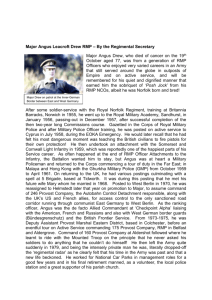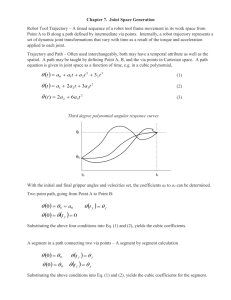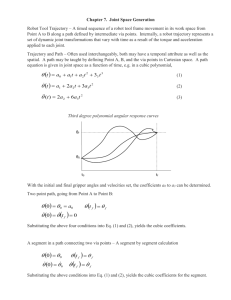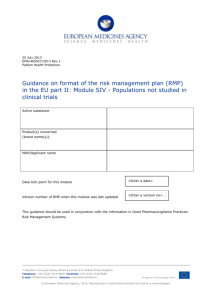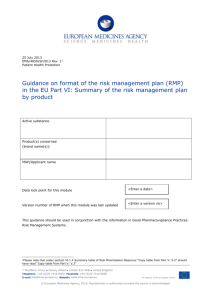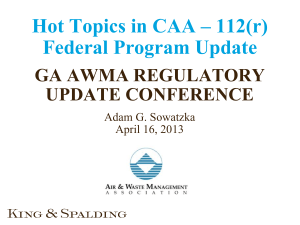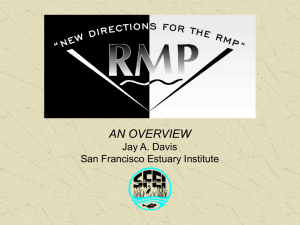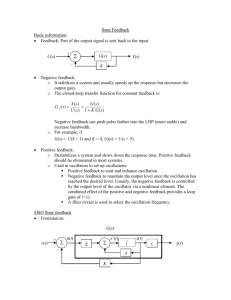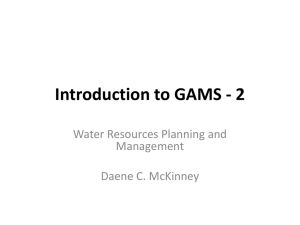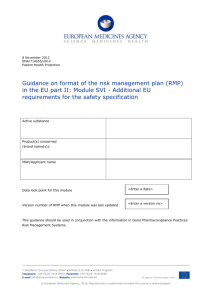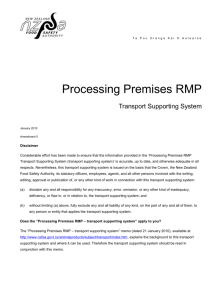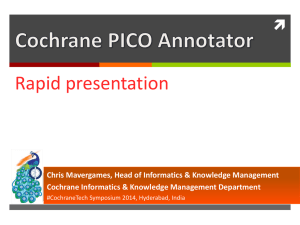Guidance on format of the RMP in the EU part II
advertisement
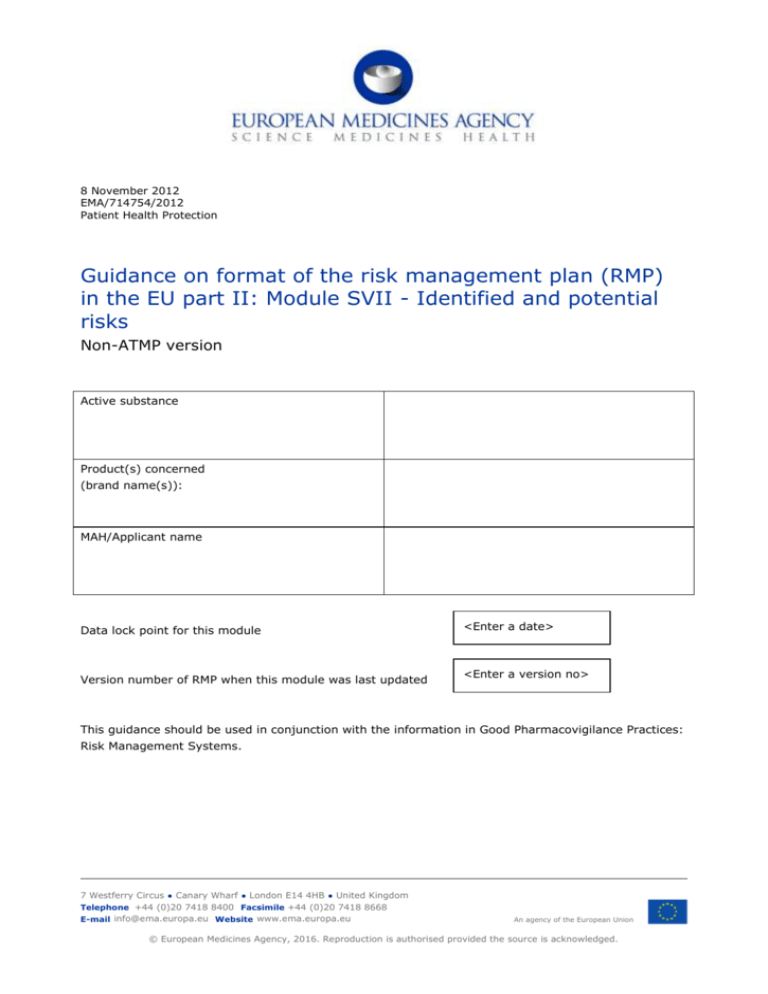
8 November 2012 EMA/714754/2012 Patient Health Protection Guidance on format of the risk management plan (RMP) in the EU part II: Module SVII - Identified and potential risks Non-ATMP version Active substance Product(s) concerned (brand name(s)): MAH/Applicant name Data lock point for this module Version number of RMP when this module was last updated <Enter a date> <Enter a version no> This guidance should be used in conjunction with the information in Good Pharmacovigilance Practices: Risk Management Systems. 7 Westferry Circus ● Canary Wharf ● London E14 4HB ● United Kingdom Telephone +44 (0)20 7418 8400 Facsimile +44 (0)20 7418 8668 E-mail info@ema.europa.eu Website www.ema.europa.eu An agency of the European Union © European Medicines Agency, 2016. Reproduction is authorised provided the source is acknowledged. This RMP module should provide more information on the important identified and potential risks. This RMP section should be concise and should not be a data dump of tables or lists of adverse reactions from clinical trials, or the proposed or actual contents of section 4.8 of the summary of product characteristics (SmPC). It should include only the important identified and potential adverse events/reactions, important identified and potential interactions with other medicinal products, foods and other substances, and the important pharmacological class effects. What constitutes an important risk will depend upon several factors including the impact on the individual patient, the seriousness of the risk and the impact on public health. Normally, any risk which is clinically important and which is/is likely to be included in the contraindications, or warnings and precautions section of the summary of product characteristics (SmPC) should be included here. In addition, risks, which whilst not normally serious enough to require specific warnings or precautions, but which occur in a significant proportion of the treated population, affect the quality of the treated person’s life, and which could lead to serious consequences if untreated, should also be considered for inclusion, e.g. severe nausea and vomiting with chemotherapy. For some products, disposal of the used product may constitute a safety concern, e.g. transdermal patches where there may be significant amounts of active substance remaining in the patch when it is discarded. There may also be occasions where there is an environmental concern over product disposal because of known harmful effects on the environment, e.g. substances which are particularly hazardous to aquatic life which should not be disposed of in landfill sites. Because of the need for different additional categories of risks to be considered with advanced therapy medicinal products, a different version of the template for RMP module SVII is available for products classified as advanced medicinal products. Only one version of the template of RMP module SVII should be used in a RMP. SVII.1 Newly identified safety concerns (since this module was last submitted) Safety concern Details Source New studies proposed in pharmacovigilance plan? Yes/No New risk minimisation actions proposed? Yes/No Guidance on format of the risk management plan (RMP) in the EU part II: Module SVII - Identified and potential risks EMA/714754/2012 Page 2/6 SVII.2 Recent study reports with implications for safety concerns Study reports (either interim or final, from whichever type of study), since the last RMP, which contain results which have a significant impact on an existing safety concern should be discussed here. The conclusions should be incorporated into the other sections and modules of the safety specification as appropriate with detailed information on the risk provided in SVII.3. Details of the above safety concerns should also be provided below. SVII.3 Details of important identified and potential risks from clinical development and post-authorisation experience (including newly identified) This RMP section should provide information on the important identified and important potential risks. This section should be concise and should NOT be a data dump of tables or lists of adverse reactions from clinical trials, or the proposed or actual content of section 4.8 of the summary of product characteristics. For most RMPs involving single products, risks which relate specifically to an indication or formulation can usually be handled as individual safety concerns, e.g. accidental IV administration could be a safety concern in a single product with both oral and subcutaneous forms. It may be appropriate to include risks associated with a significant change to a manufacturing process (particularly for biologicals) and risks associated with medication error For RMPs covering multiple products where there are significant differences in the identified and potential risks for different products, it may be appropriate to categorise the risks to make it clearer which risks relate to which product. Division of identified and potential risks using the headings below should only be considered when the risks clearly do not apply to some products and lack of separation could cause confusion. Headings which could be considered include: Risks relating to the active substance This would include important identified or potential risks which are common to all formulations, routes of administration and target populations. It is likely that most risks will fall into this category for the majority of products. Risks related to a specific formulation, indication or route of administration Examples might include an RMP with two products with completely different indications: e.g. sildenafil with an indication in one product for erectile dysfunction and in a second product for pulmonary arterial hypertension. Risks relating to a specific target population The paediatric population is an obvious example of a target population where there may be additional risks relating to physical, mental and Guidance on format of the risk management plan (RMP) in the EU part II: Module SVII - Identified and potential risks EMA/714754/2012 Page 3/6 sexual development which would not be relevant to a product intended solely for adult patients. Risks associated with switch to non-prescription status For each important identified and important potential risk1 provide the following information if available: NB: If preferred this can be provided outside of the table format using the sections (as detailed in the first column) as paragraph headings. Identified/potential Risk1 <> Frequency with 95 % CI State clearly which frequency parameter is being used e.g. incidence rate or incidence risk and the data source e.g. blinded clinical trial population, epidemiological study. For identified risks incidence should be presented for the whole population and relevant subpopulation categories. (see also section V.B.8.7.3 of GVP Module V) Where there are clear differences in rates between populations, this should be discussed Seriousness/outcomes Tabulate the distribution of outcomes e.g. % fatal, % recovered/with/without treatment/sequelae, % not recovered, % hospitalised etc. Severity and nature of risk e.g. tabulate grades of severity where available Background incidence/prevalence Background incidence/prevalence of the risk in the unexposed target population(s) Risk groups or risk factors Describe patient factors, dose, time or other factors where available including additive or synergistic factors Potential mechanisms Describe Preventability Provide data on predictability or preventability of ADR, effect of known risk factors, mitigation through early detection Impact on individual patient effect on quality of life Potential public health impact of Describe or enumerate if possible, using e.g. Numbers Needed to Harm and/or expected number of patients affected, safety concern 1 For definitions see Good Vigilance Practices (GVP) Module V, chapter V.B.1. Guidance on format of the risk management plan (RMP) in the EU part II: Module SVII - Identified and potential risks EMA/714754/2012 Page 4/6 Identified/potential Risk1 <> hospitalisations, fatalities predicted population use. given the Evidence source Identify, briefly describe and cross refer to supporting data in CTD or annex MedDRA terms Terms used in Annex 1 for post marketing surveillance SVII.4 Identified and potential interactions SVII.4.1 Overview of potential for interactions Discuss the main routes of metabolism and elimination and the potential for interactions due to effects on CYP enzymes, drug transporters etc. SVII.4.2 Important identified and potential interactions Identified and potential pharmacokinetic and pharmacodynamic interactions should be discussed in relation to both the treatments for the condition, but also in relation to commonly used medications in the target population. Important interactions with herbal medicines or with food should also be discussed. Interacting substance(s) <> Effect of interaction Evidence source Possible mechanisms Potential health risk Discussion Consider including “interactions” as a safety concern in Part II Module SVIII. SVII.5 Pharmacological class effects Identify risks which are believed to be common to the pharmacological class. SVII.5.1 risks Pharmacological class risks already included as important identified or potential For risks which have been included above in “Details of important and identified and potential risks from clinical development and postauthorisation experience” above, provide the following details below. Guidance on format of the risk management plan (RMP) in the EU part II: Module SVII - Identified and potential risks EMA/714754/2012 Page 5/6 Risk Frequency in clinical Frequency seen with trials of medicinal other products in product same Comment pharmacological class (source of data/journal reference) Risk 1 <E.g. Product A Product B Product C Review of adverse reactions BMJ 2008: 5; 214-217> Risk 2 etc. SVII.5.2 Important pharmacological class effects not discussed above The table below should be provided for each important risk which has not been included in RMP module SVII “Details of important identified and potential risks from clinical development and post-authorisation experience” (above) but which is believed to be common to the pharmacological class. If an important potential risk, associated with other members of the pharmacological class, is not thought to be a safety concern with the medicinal product this should be justified and supporting evidence provided. Potential Risk < > Seriousness/outcomes Severity and nature of risk e.g. tabulate grades of severity where available Frequency with other members of the same or similar pharmacological class with 95 % CI Risk groups or risk factors Describe use, dose, time and susceptibility data or other factors where available. Potential mechanisms Describe Comment Guidance on format of the risk management plan (RMP) in the EU part II: Module SVII - Identified and potential risks EMA/714754/2012 Page 6/6
